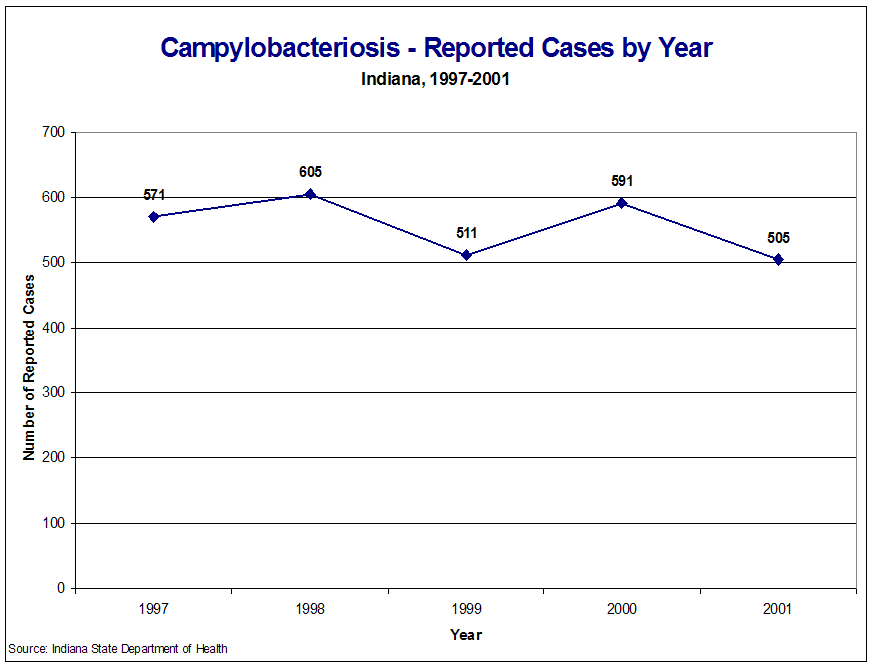Figure Cam1: Campylobacteriosis - Reported Cases by Year, Indiana, 1997-2001

2001 Indiana Report of Infectious Diseases |
View ISDH's Quick Facts on Campylobacter
View CDC's Campylobacter Infections Page
Rates presented are per 100,000 population and are based on the 2000 U.S. Census.
| Cases | Incidence Rate |
|
| Total | 505 | 8.3 |
| Race-specific cases and rates1 | ||
| White | 329 | 6.2 |
| Black | 19 | 3.7* |
| Other2 | 6 | 2.4* |
| Sex-specific cases and rates3 | ||
| Female | 234 | 7.6 |
| Male | 269 | 9.0 |
Campylobacteriosis is a bacterial disease usually transmitted through raw or undercooked foods of animal origin or foods cross-contaminated by animal products or feces. It can also be transmitted by untreated or contaminated water or person-to-person. In Indiana, the following risk factors are the most common: contact with domestic animals (pets), chicken consumption within five days prior to illness, contact with someone with similar symptoms, travel outside of Indiana, contact with untreated water, and contact with livestock.
There were 505 cases of campylobacteriosis reported in Indiana in 2001, with a rate of 8.3 cases per 100,000 population. This represents a decrease from 2000 (Figure Cam1). Incidence of disease was greatest during the summer months, as shown in Figure Cam2. This seasonal variation has been typical for campylobacteriosis in previous years.
Age-specific rates were greatest for infants (24.8) followed by preschoolers (16.2) (Figure Cam3).
The sex-specific rate for males (9.0) was higher than that for females (7.6). The race-specific rate for whites (6.2) was higher than that for blacks (3.7) or other races (2.4), however, 151 cases (30%) did not report race data.Of those counties that reported 5 or more cases, Franklin County had the highest incidence rate (31.6), followed by Orange (31.1), Boone (19.5), and Daviess (16.8) (Figure Cam4). The number of reported cases for Indiana counties can be found in Table Cam1.
There were no outbreaks of campylobacteriosis reported in Indiana in 2001.
Back to Top of Article
Back to Table of Contents
|
Figure Cam1: Campylobacteriosis - Reported Cases by Year, Indiana, 1997-2001 |
|
|
Back to Reference in Text
Back to Top of Article
|
Figure Cam2: Campylobacteriosis - Reported Cases by Month, Indiana, 2001 |
|
|
Back to Reference in Text
Back to Top of Article
|
Figure Cam3: Campylobacteriosis - Incidence Rates by Age Group, Indiana, 2001 |
|
|
Back to Reference in Text
Back to Top of Article
|
Figure Cam4: Campylobacteriosis - Incidence Rates by County, Indiana, 2001 |
|
|
Back to Reference in Text
Back to Top of Article
|
Table Cam1: Campylobacteriosis - Reported Cases by County, Indiana, 2001 |
||||||||||||||||||||||||||||||||||||||||||||||||||||||||||||||||||||||||||||||||||||
|
||||||||||||||||||||||||||||||||||||||||||||||||||||||||||||||||||||||||||||||||||||
Back to Reference in Text
Back to Top of Article
1 - Race was unknown for 151 of the reported cases.
2 - "Other" includes American Indian/Alaska Native, Asian, Native Hawaiian/Pacific Islander, and multiracial.
3 - Sex was unknown for 2 of the reported cases.
* - Rate based on less than 20 cases and should be considered unstable.
Back to Table of Contents
[an error occurred while processing this directive]